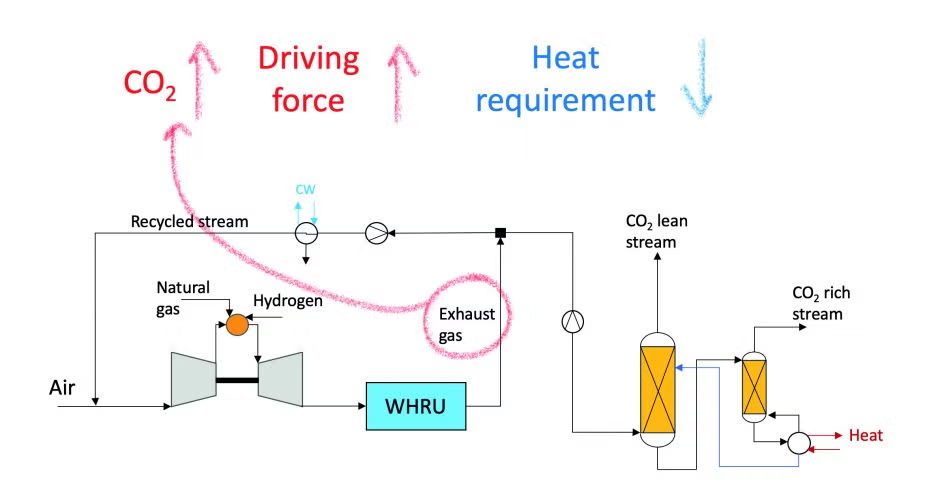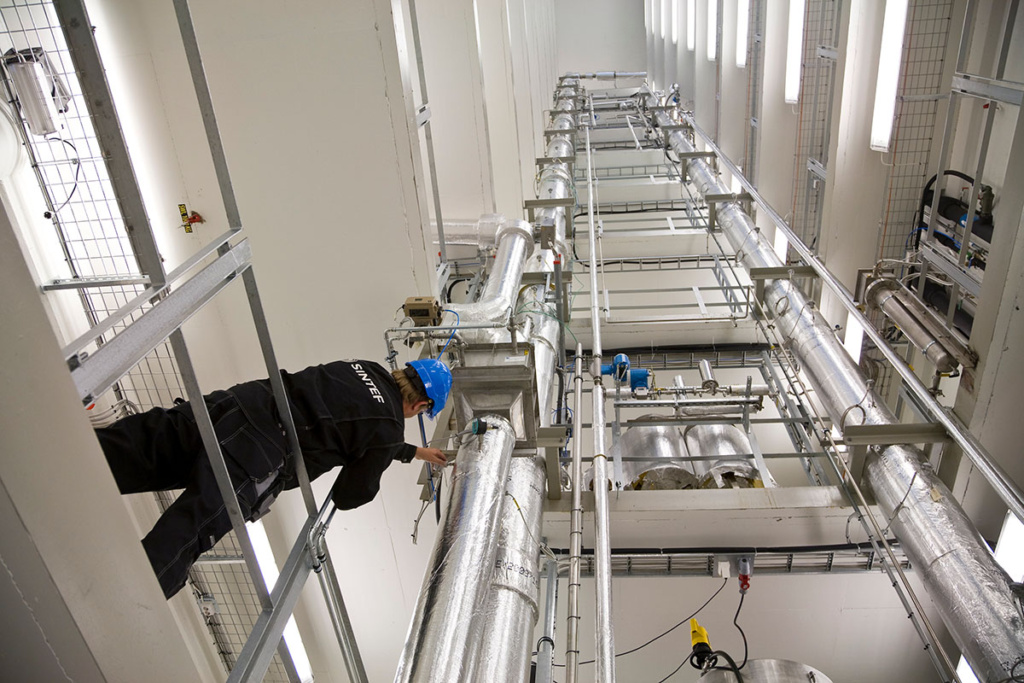
Power production from natural gas combustion remains a cornerstone of our energy systems, both for industrial and domestic use all over the world. It is set to play a pivotal role during the shift toward decarbonised energy, in parallel with renewables and assisting for their intermittent nature. However, its reliance on combustion brings a challenge: CO2 emissions.
To bridge the gap between energy demand and climate goals, the adoption of CO2 capture technologies for power plant exhaust gases emerges as a game-changer, reducing the emissions up to 90% and paving the way for cleaner energy production.
A promising method: EGR
In the European research project TRANSITION, we at SINTEF are collaborating with our research and industry partners – University of Florence, TotalEnergies, Baker Hughes, CERFACS, and DLR – to achieve further advancements in carbon-neutral power generation from natural gas fired power plants using gas turbines. To do this, access to a highly efficient carbon capture process is crucial.
One key factor influencing CO2 capture efficiency is the concentration of carbon dioxide in the exhaust gas. The higher the concentration, the lower the energy demand for the CO2 capture process.
A promising approach to boost CO2 concentration is exhaust gas recirculation (EGR). This technique recycles a portion of the exhaust gases back to the compressor inlet of the gas turbine, while the rest is directed to the CO2 capture system. By mixing the recycled exhaust gas with the inlet air, the resulting exhausts become richer in CO2.
Additionally, EGR reduces the total volume of exhaust gas processed by the CO2 capture system, resulting in smaller equipment sizes and, thus, lower costs. Together, these benefits position EGR as a compelling strategy for enhancing the efficiency and cost-effectiveness of CO2 capture in gas turbines.

But a major technology bottleneck for EGR lies in the combustor of the power plant, where it has been established that the amount of exhaust gas that can be recycled is limited to 35-40% before causing combustion instability.
The more EGR, the better
A recent simulation study we did at SINTEF under the TRANSITION project, investigated the impact of exhaust gas recirculation on a natural gas fuelled combined cycle power plant, highlighting challenges and potential.
The results first reaffirm what was already observed in the literature, in that increasing the EGR ratio results in reduced energy penalty and smaller equipment size. The additional energy penalties of the overall system were also analysed in the SINTEF study, confirming that the CO2 capture energy requirement is predominant, and that the design of the system should aim at minimising it.
In the study, high and impractical EGR ratios (well above the accepted 35-40% limit) were purposely tested. Interestingly, the results showed that the benefit in CO2 capture progressively increases with EGR, showing that the more EGR, the better.
This result means that effort put into further pushing the combustion limit will positively affect the capture plant. And this is the ultimate objective of the TRANSITION project, to investigate hydrogen piloting of the combustor at high EGR ratio.
The new approach: Hydrogen-assisted EGR
The piloting consists of adding a relatively small amount of hydrogen into the combustor, just enough to maintain stable combustion and allow higher EGR levels. To minimise the amount of hydrogen needed, and its associated cost, clever injection strategies in the burner-combustor arrangement are being developed.
The most promising configuration designed by Baker-Hughes and the University of Florence will finally be tested in relevant high-pressure conditions at the partner site DLR, Germany. As the energy consumption is a key driver of operating costs, and equipment sizes are a key driver of capital costs, the SINTEF study results represent a basis for further techno-economic evaluations.
Although the power sector is going through a radical change, where renewable electricity is gradually and inexorably increasing its share, natural gas power generation is expected to continue play an important role in balancing the power system and increasing its flexibility and reliability.
Reducing the emissions from natural gas fuelled combined cycle plants is, therefore, a necessity. And CO2 capture is currently the lone option available to pursue such reduction.
Despite that, the economic penalties incurred by deploying CO2 capture are slowing down its uptake. Exhaust gas recirculation shows substantial promise as a means of improving cost effectiveness but is not yet commercially available. We at SINTEF, in collaboration with our partners from the TRANSITION project, will strive to further advance EGR towards technological maturity continuing to address remaining limitations via focused research.
If you are curious to know more, you can always reach out directly to us. But we also recently presented the SINTEF study at the latest ASME Turbo Expo conference in London – which caught the eye of industry magazine Modern Power Systems.

Integrating exhaust gas recirculation for reduced CO2 emissions from combined cycle power plants
The latest Asme Turbo Expo conference took place in London and attracted 2500 plus turbomachinery and propulsion engineering leaders from industry, academia, and government. In this context, SINTEF Energy Research presented research results demonstrating how the efficiency and costs of a natural gas combined cycle (NGCC) power plant with CO2 capture can be improved by adopting an innovative approach: namely hydrogen-assisted exhaust gas recirculation (EGR).

Ekspertise
Forsyningssikkerhet
SINTEF har ekspertkompetanse og erfaring innenfor temaet forsyningssikkerhet.




